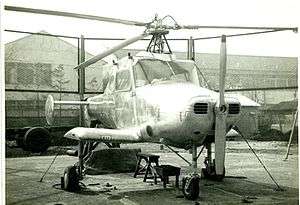Kayaba Heliplane
The Kayaba Heliplane Type-1 (Japanese: ヘリプレーン 1型) was a gyrodyne (compound autogyro) designed by Shiro Kayaba and prototyped by Kayaba Industry in Japan during the early 1950s.
| Heliplane | |
|---|---|
 | |
| Role | Gyrodyne |
| National origin | Japan |
| Manufacturer | Kayaba Industry |
| Status | Canceled |
| Number built | 1 |
Design and development
In March 1952, Kayaba Industry began the development of the Heliplane, a Gyrodyne, which combines the advantages of autogyro and helicopter. Kayaba took advantage of experience producing the Ka-Go Ka-1 and Ka-2 autogyros, intended for reconnaissance, artillery-spotting and anti-submarine use, developed during World War II.
Kayaba received a subsidy of 2 million yen from the Government of Japan or the development of the aircraft, as well as 1.2 million yen from Ishikawajima Heavy Industries (IHI) for development of the rotor-tip ramjets.
The aircraft was modified from Cessna 170B. The wing was removed, and a three-blade main rotor with support structure was installed on the upper part of the fuselage. In addition short-span fixed wings were fitted either side of the lower fuselage. For initial testing the fixed pitch wooden propeller of the Cessna 170 was retained, but a 3-bladed variable-pitch propeller was to be fitted for flight testing.
Ishikawajima had developed the Ne-0 (Japanese: 石川島 ネ-0) ramjet during the war and tested it in flight beneath a Kawasaki Ki-48-II. A development of this ramjet was envisaged as the power source for the rotor drive. At takeoff, the rotor was to be started using the tip mounted ramjet engines, then transition to an autogyro powered by the propeller engine after the ramjets were stopped.
One prototype unit was produced and almost completed in March 1954 (Showa 29), but was damaged in July 1954 during tie-down testing. Further development was cancelled before the aircraft was flown.

Specifications (Heliplane)
Data from sjac.or.jp, Handbook of Japanese Aircraft and Model Art[2][3][4]
General characteristics
- Crew: 1 or 2
- Capacity: 1 or 2
- Length: 7.4 m (24 ft 3 in) fuselage
- Wingspan: 2.74 m (9 ft 0 in) stub wings
- Height: 2.83 m (9 ft 3 in)
- Airfoil: NACA 2412
- Powerplant: 1 × Continental Motors air-cooled 6-cylinder horizontally-opposed piston engine E-190[5], 130 kW (180[5] hp) [6]
- Powerplant: 3 × unknown rotor tip ramjet, 0.245 kN (55 lbf) thrust each
- Main rotor diameter: 11 m (36 ft 1 in)
- Main rotor area: 95 m2 (1,020 sq ft) three-bladed bonded metal rotor rotating at 310 rpm
- Propellers: 2-bladed wooden fixed pitch propeller
Performance
- Maximum speed: 170 km/h (110 mph, 92 kn) projected
- Cruise speed: 120 km/h (75 mph, 65 kn) projected
- Range: 360 km (220 mi, 190 nmi) projected
- Service ceiling: 4,000 m (13,000 ft) projected
References
- National Museum of Nature and Science Ueno Tokyo Japan.
- "ヘリプレーン1型" (pdf). sjac.or.jp (in Japanese). p. 100. Retrieved 11 February 2017.
- unknown (1992). Handbook of Japanese Aircraft 1951 - 1989, Vol. 2 (in Japanese). Tokyo: Model Art.
- "日本航空機辞典 下巻 昭和26年〜平成元年 (1951〜1989)". www.modelart-shop.jp (in Japanese). Tokyo: 有限会社 モデルアート社 (Model Art Limited). 1992. Retrieved 11 February 2017.
- "Japanese Imperial Army Artillery Unit Ka-go Observation Aircraft-Phantom Autogyro Development Story by Eiji Tamate (陸軍 カ号観測機 - 幻のオートジャイロ開発物語 - 玉手 榮治)". Ushio shobo - kojin shinsha Co., Ltd(株式会社潮書房光人新社),Eiji Tamate (玉手 榮治): 368–375. 22 March 2020. Retrieved 23 March 2020.
- "Re-Rising Sun". Flight: 411–413. 1 April 1955. Retrieved 11 February 2017.
External links
- <Chronological record> Helicopter half-century in Japan (1945-50s) - Japan Helicopter Technology Association official website. Viewed on December 5, 2002, Retrieved February 10, 2017.
- Attempt at the dawn of the helicopter in our Japan Aviation Now / Modern aeronautics (rewritten draft of the 37th Airplane Symposium hosted by the Japan Aviation Space Association). 1999, November 26, 2015. Retrieved February 10 2017.
- The birthplace collection / The birthplace of the jet engine in Japan. Retrieved February 11 2017.
- Gas turbine gallery _ Public benefit organization The Japan Gas Turbine Society. Retrieved February 11 2017.